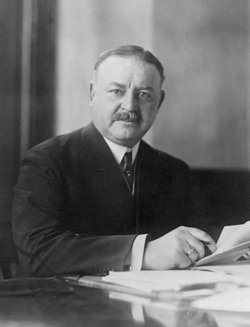Law Enforcement Figure. He was a New York City police detective who introduced a standard system of fingerprinting in the United States. In 1906, he was the first to use fingerprints to identify a criminal and the first to obtain a conviction case with fingerprint evidence in a burglary case. He individualized defendant Charles Crispi's fingerprint on a pane of glass removed from a door at the crime scene point of entry. In a dramatic courtroom demonstration using the jury's fingerprints, he explained the science of fingerprinting and proving Crispi's guilt. Using fingerprints, he also identified a dismembered female body that was found murdered. Dr. William Heinecke, a Manhattan chemist, developed the chemical details of these fingerprinting standards, which the two men made a profitable business of selling to law enforcement agencies as well as the government for fingerprinting military personnel and all Federal and civil service employees. The same combination of ink and paper was to be used for the fingerprinting. Carrying his knowledge to Europe in 1911, he learned about European advancement in criminology while teaching fingerprinting. In 1914, the French scientist and author Dr. Edmond Locard published "The Legal Evidence by the Fingerprints," which was based on Faurot's conviction as well as other research. Faurot rose to become a deputy police commissioner before his retirement in 1926 after serving for thirty years. Although an American agricultural scientist, Thomas Taylor, first proposed in 1877 the use of palm and finger marks to identify criminals, fingerprinting was considered a junk science until Faurot's application of the science. A "Time" magazine article on his work was published in April of 1933, and his obituary in the "New York Times" gained attention.
Law Enforcement Figure. He was a New York City police detective who introduced a standard system of fingerprinting in the United States. In 1906, he was the first to use fingerprints to identify a criminal and the first to obtain a conviction case with fingerprint evidence in a burglary case. He individualized defendant Charles Crispi's fingerprint on a pane of glass removed from a door at the crime scene point of entry. In a dramatic courtroom demonstration using the jury's fingerprints, he explained the science of fingerprinting and proving Crispi's guilt. Using fingerprints, he also identified a dismembered female body that was found murdered. Dr. William Heinecke, a Manhattan chemist, developed the chemical details of these fingerprinting standards, which the two men made a profitable business of selling to law enforcement agencies as well as the government for fingerprinting military personnel and all Federal and civil service employees. The same combination of ink and paper was to be used for the fingerprinting. Carrying his knowledge to Europe in 1911, he learned about European advancement in criminology while teaching fingerprinting. In 1914, the French scientist and author Dr. Edmond Locard published "The Legal Evidence by the Fingerprints," which was based on Faurot's conviction as well as other research. Faurot rose to become a deputy police commissioner before his retirement in 1926 after serving for thirty years. Although an American agricultural scientist, Thomas Taylor, first proposed in 1877 the use of palm and finger marks to identify criminals, fingerprinting was considered a junk science until Faurot's application of the science. A "Time" magazine article on his work was published in April of 1933, and his obituary in the "New York Times" gained attention.
Bio by: Linda Davis
Family Members
Advertisement




